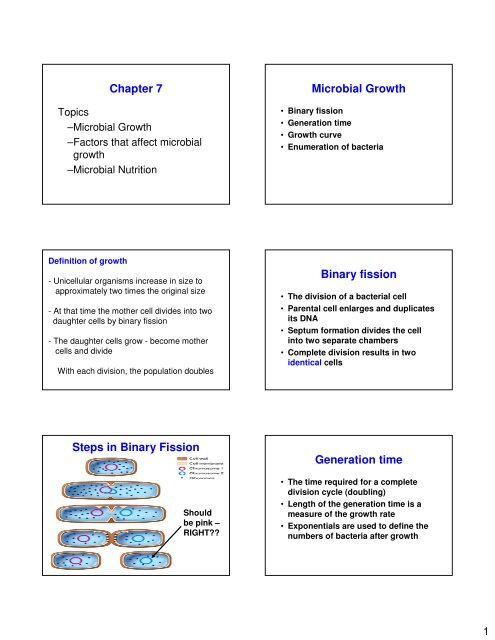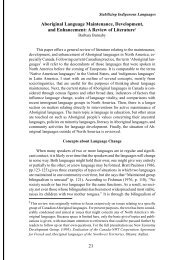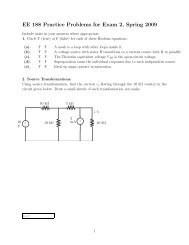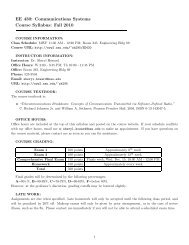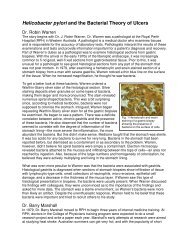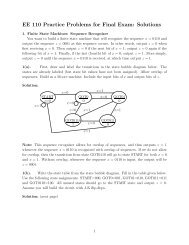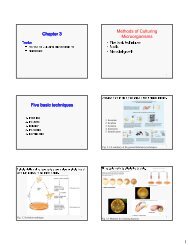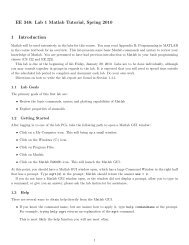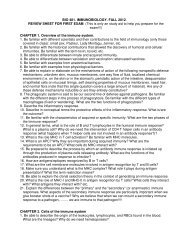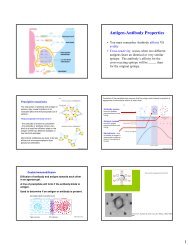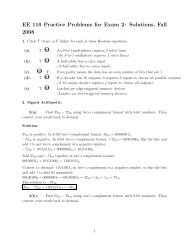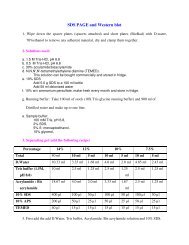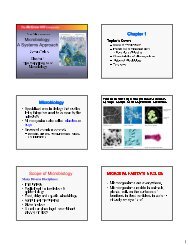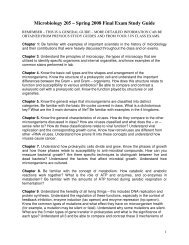Chapter 7 Microbial Growth Binary fission Steps in Binary Fission ...
Chapter 7 Microbial Growth Binary fission Steps in Binary Fission ...
Chapter 7 Microbial Growth Binary fission Steps in Binary Fission ...
- No tags were found...
Create successful ePaper yourself
Turn your PDF publications into a flip-book with our unique Google optimized e-Paper software.
<strong>Chapter</strong> 7Topics–<strong>Microbial</strong> <strong>Growth</strong>–Factors that affect microbialgrowth–<strong>Microbial</strong> Nutrition<strong>Microbial</strong> <strong>Growth</strong>• <strong>B<strong>in</strong>ary</strong> <strong>fission</strong>• Generation time• <strong>Growth</strong> curve• Enumeration of bacteriaDef<strong>in</strong>ition of growth- Unicellular organisms <strong>in</strong>crease <strong>in</strong> size toapproximately two times the orig<strong>in</strong>al size- At that time the mother cell divides <strong>in</strong>to twodaughter cells by b<strong>in</strong>ary <strong>fission</strong>- The daughter cells grow - become mothercells and divideWith each division, the population doubles<strong>B<strong>in</strong>ary</strong> <strong>fission</strong>• The division of a bacterial cell• Parental cell enlarges and duplicatesits DNA• Septum formation divides the cell<strong>in</strong>to two separate chambers• Complete division results <strong>in</strong> twoidentical cells<strong>Steps</strong> <strong>in</strong> <strong>B<strong>in</strong>ary</strong> <strong>Fission</strong>Shouldbe p<strong>in</strong>k –RIGHT??Generation time• The time required for a completedivision cycle (doubl<strong>in</strong>g)• Length of the generation time is ameasure of the growth rate• Exponentials are used to def<strong>in</strong>e thenumbers of bacteria after growth1
LogSynchronous growth vs.nonsynchronous growth<strong>Growth</strong> curve• Lag phase• Log phase• Stationary phase• Death phase2
Enumeration of bacteria• Direct cell count - multiple methods• Turbidity• Automated devices– Coulter counter– Flow cytometerDifferences <strong>in</strong> techniques - can you tellthe difference between live/dead?One bacterium results <strong>in</strong>one bacterial colonyCountable number of coloniesLimitation = 30 to 300 per plateTurbidityDirect counts by microscopy - can takeadvantage of sta<strong>in</strong><strong>in</strong>g techniques welearned <strong>in</strong> <strong>Chapter</strong> 33
Mechanical or automated countersFactors that Effect <strong>Microbial</strong><strong>Growth</strong>• Temperature• Gas• pH• Osmotic pressure• Other factors• <strong>Microbial</strong> associationTemperature-Psychrophiles obligate (Bacillus globisporus),facultative (Xanthomonas pharmicola) – optimaltemperature for growth below 15°C- Mesophiles - 20 to 40 o C - thermoduricorganisms can survive elevated temperatures,but grow best at moderate temperatures- Thermophiles – organisms that normally growbest at >45°CGases• Two gases that most <strong>in</strong>fluencemicrobial growth– Oxygen• Respiration• Oxidiz<strong>in</strong>g agent– Carbon dioxideOxygen -- Obligate aerobes- Obligate anaerobes- Facultative anaerobes- Microaerophiles - do not grow at normalatmospheric concentrations of O 2 - soilmicroorgansims- Capnophiles - microaerophiles that areCO 2lov<strong>in</strong>g4
Obligate aerobe• Requires oxygen for metabolism• Possess enzymes that can neutralizethe toxic oxygen metabolites– Superoxide dismutase andcatalase• Ex. Most fungi, protozoa, andbacteriaFacultative anaerobe• Does not require oxygen formetabolism, but can grow <strong>in</strong> its presence• Dur<strong>in</strong>g oxygen limitation states, anaerobicrespiration or fermentation occurs• Possess superoxide dismutase andcatalase• Ex. Gram negative pathogensObligate anaerobes• Cannot use oxygen for metabolism• Do not possess superoxide dismutaseand catalase• The presence of oxygen is toxic to thecell• Ex - dental pathogens, <strong>in</strong>test<strong>in</strong>alpathogens, deep <strong>in</strong> tissuespHpH - negative logarithm of thehydrogen ion concentration of anaqueous solution• Most cells grow best between pH 6 - 8• Exceptions would be acidophiles (pH 0)and alkal<strong>in</strong>ophiles (pH 10).Osmotic pressure• Halophiles• Require high salt concentrations• Withstand hypertonic conditions• Ex. Halobacterium• Facultative halophiles– Can survive high salt conditions but isnot required– Ex. Staphylococcus aureusOther factors?• Barophiles – withstand highpressures• Spores and cysts- can survive dryhabitats5
Hydrostatic pressureMost microorganisms can withstandreasonable pressures, but barophilesare highly evolved microorganisms thatgrow only at <strong>in</strong>tense pressureSome barophiles are also thermophiles- deep thermal vents <strong>in</strong> oceansEcological association• Influence microorganisms have on othermicrobes– Symbiotic relationship– Non-symbiotic relationship• Organisms that live <strong>in</strong> close nutritionalrelationship• Types– Mutualism – both organism benefit– Commensalism – one organisms benefits– Parasitism – host/microbe relationshipEcology of CommunitiesCl<strong>in</strong>t Eastwood StyleGood – help each other <strong>in</strong> communitysett<strong>in</strong>gBad – kill one another with antibiotics –take spoils of victoryUgly – live together to cause diseaseOral cavity biofilms and Co-aggregationTwo SpeciesBiofilmFormed by:S. oralis &P. acnes6
<strong>Microbial</strong> Nutrition• Sources of essential nutrients- Macronutrients: Carbon, Nitrogen, Oxygen,and Hydrogen- Micronutrients: Magnesium, Manganese,Z<strong>in</strong>c, and Nickel• Transport mechanismsCarbon source• Heterotroph (depends on other life forms)– Organic molecules– Ex. Sugars, prote<strong>in</strong>s, lipids• Autotroph (self-feeders)– Inorganic molecules– Ex. CO 2Transport mechanisms• Osmosis• Diffusion• Active transport• Endocytosis- Water movement- Selectively permeablemembrane- Concentration gradientOsmosis – water movementEqual In Burst Out Shr<strong>in</strong>kDiffusion• Net movement of molecules from a highconcentrated area to a low concentratedarea• No energy is expended (passive)• Concentration gradient and permeabilityaffect movement7
Sugar diffusion <strong>in</strong> coffeeFacilitated diffusion• Transport of polar molecules and ionsacross the membrane• No energy is expended (passive)• Carrier prote<strong>in</strong> facilitates the b<strong>in</strong>d<strong>in</strong>gand transport– Specificity– Saturation– CompetitionFacilitated diffusionActive transport• Transport of molecules aga<strong>in</strong>st agradient• Requires energy (active)• Ex. Permeases and prote<strong>in</strong> pumpstransport sugars, am<strong>in</strong>o acids, organicacids, phosphates and metal ions• Ex. Group translocation transports andmodifies specific sugarsPermeases Group translocation -usually entities are modified8
Endocytosis• Substances are taken, but are nottransported through the membrane.• Requires energy (active)• Common for eukaryotes• Ex. Phagocytosis, p<strong>in</strong>ocytosisIn summaryThe growth and division ofmicroorganisms requires a carefullychoreographed arrangement of alarge number of processes. Littleth<strong>in</strong>gs can be exceed<strong>in</strong>gly complex.9


